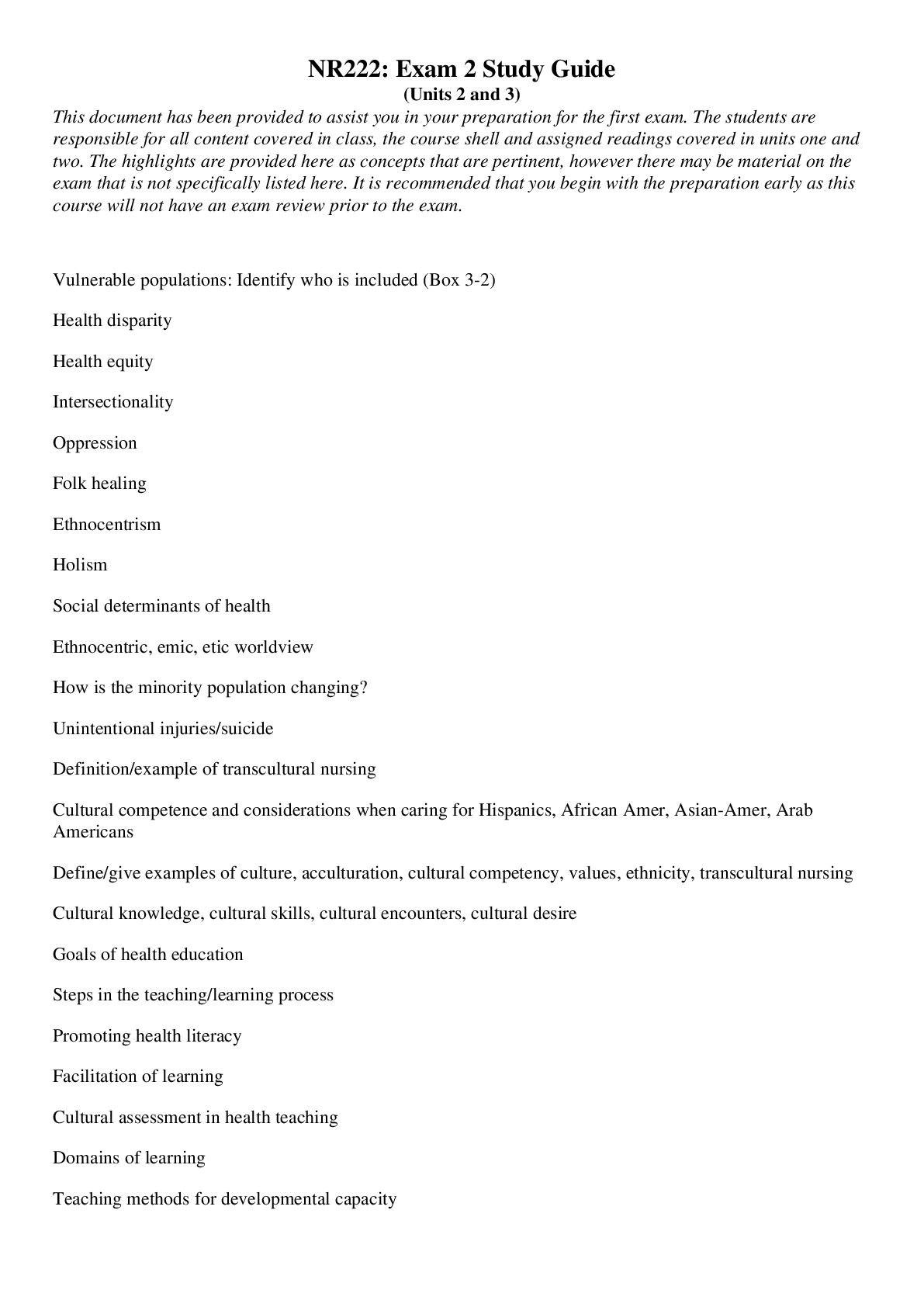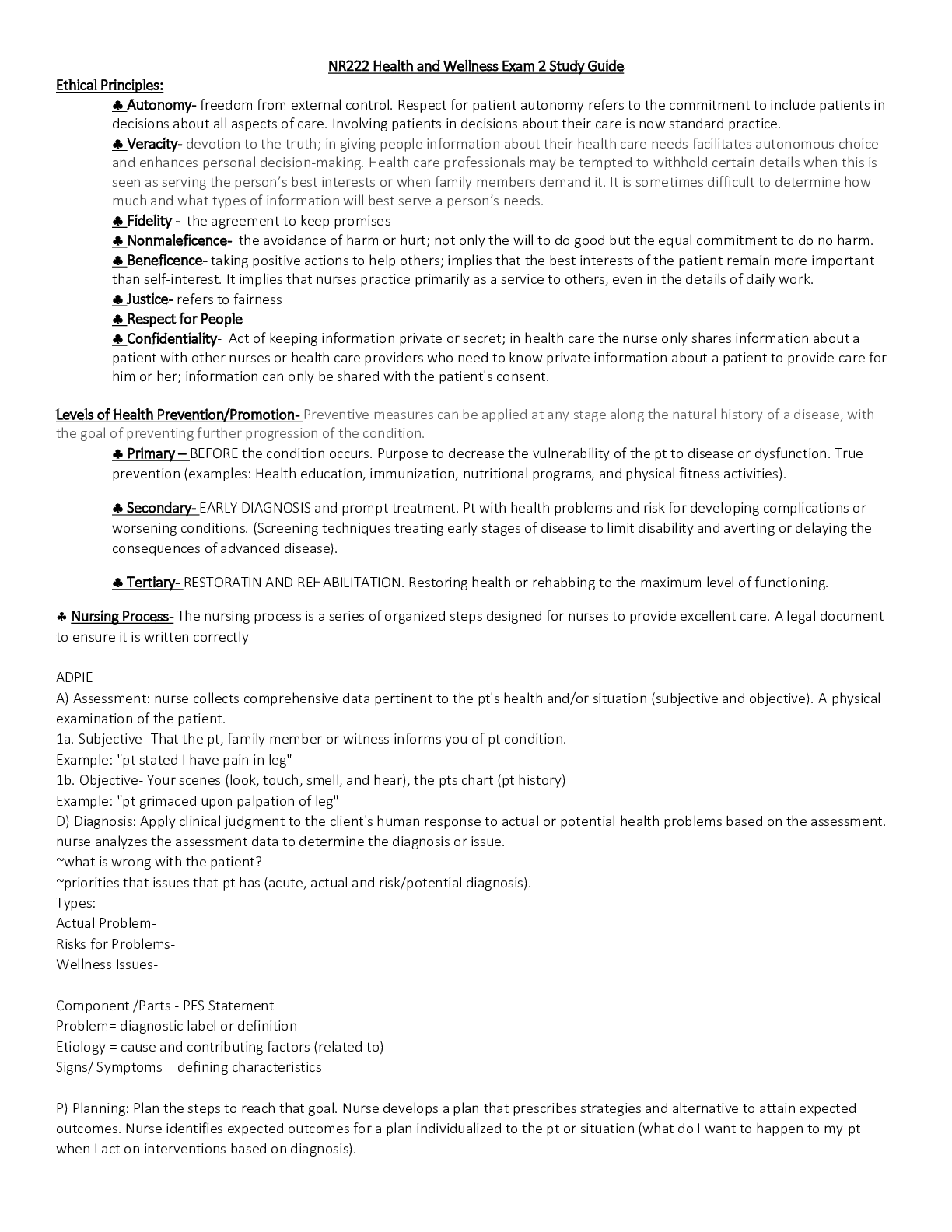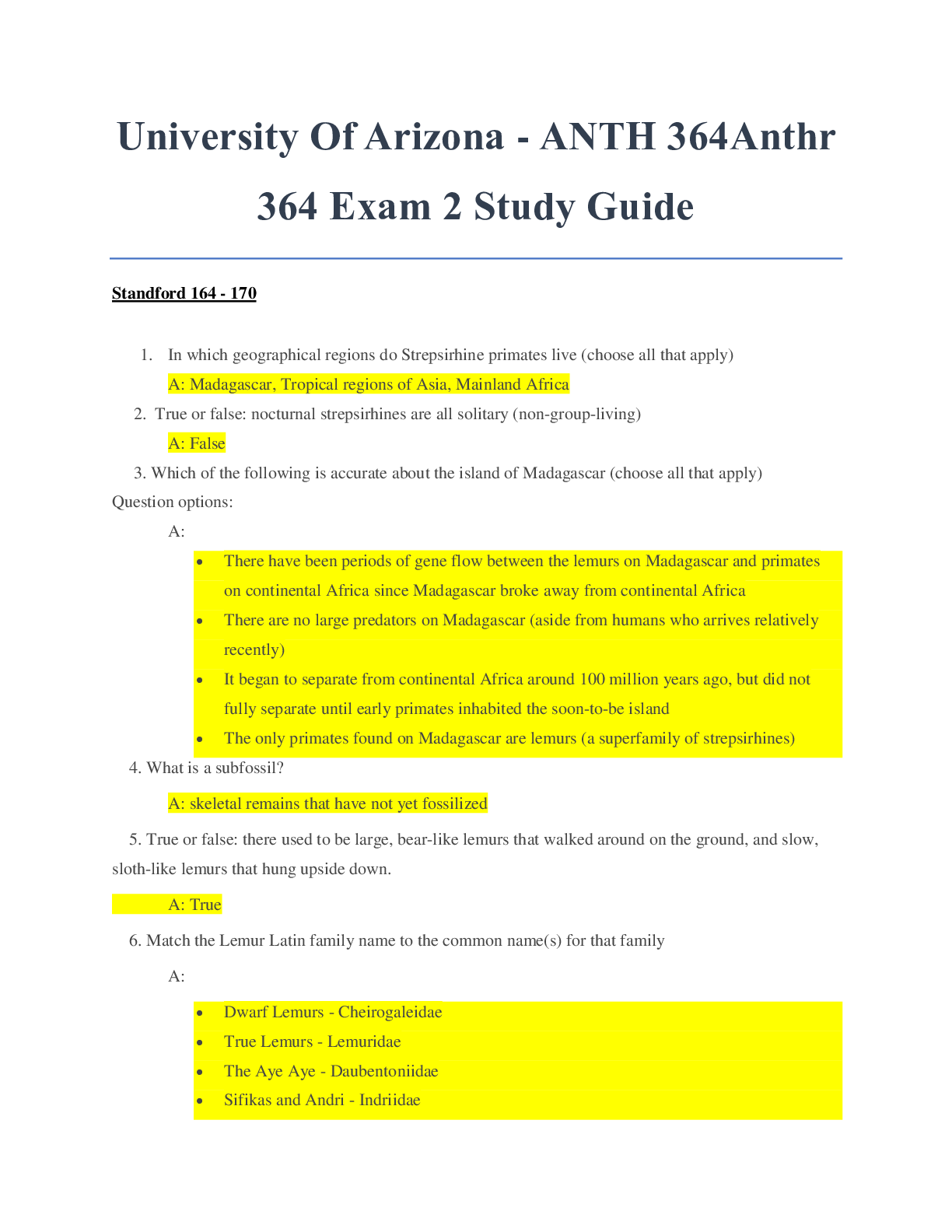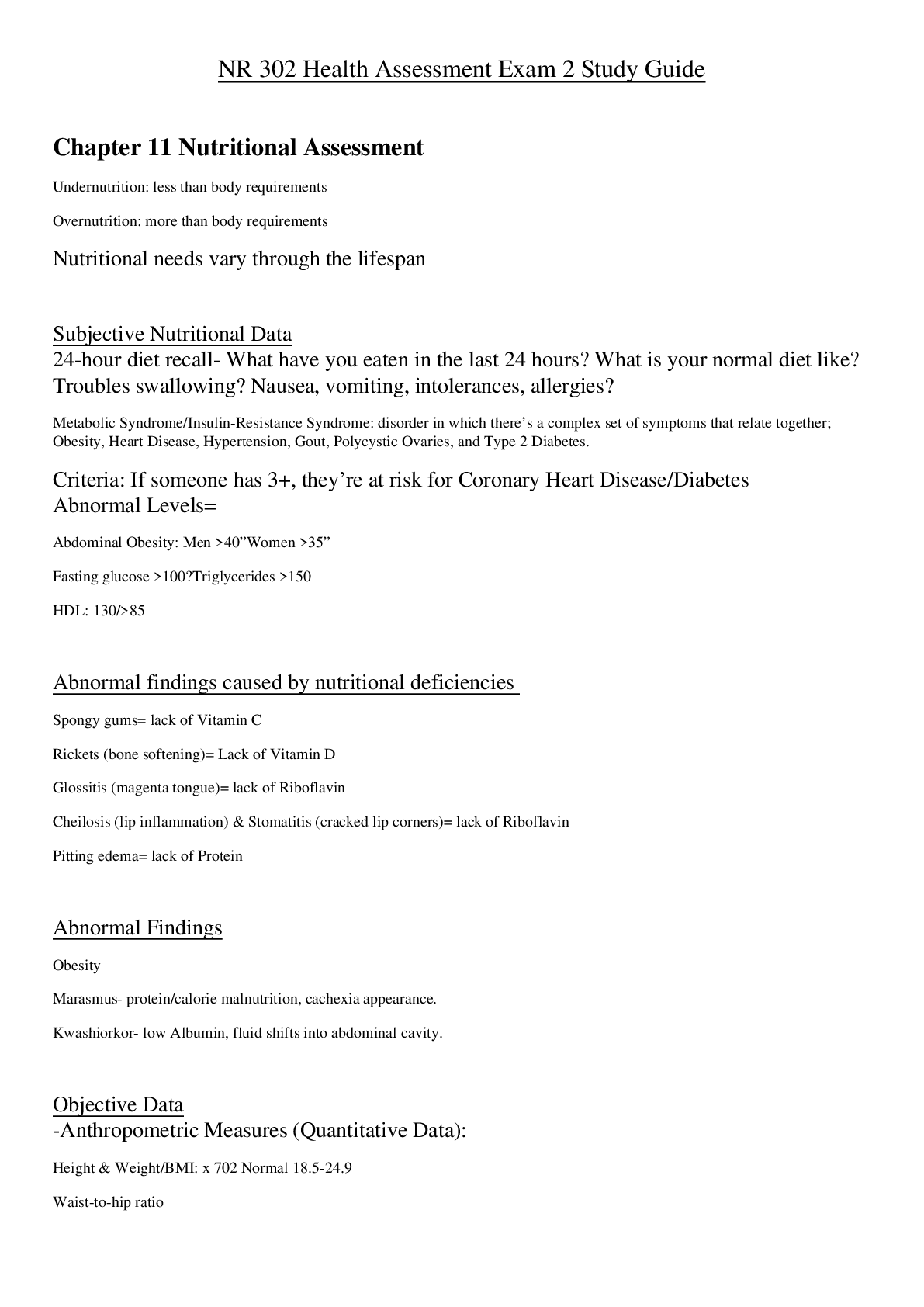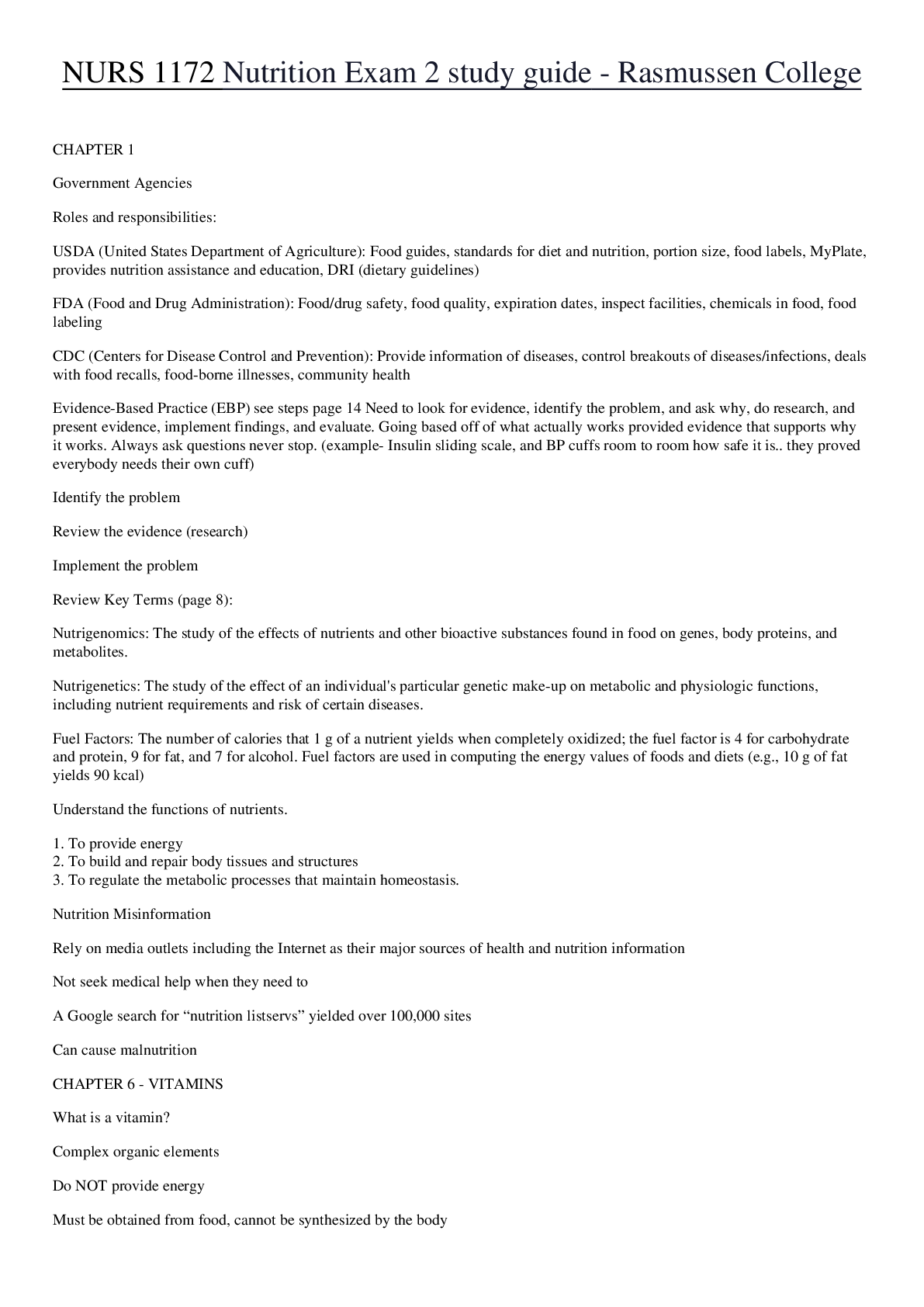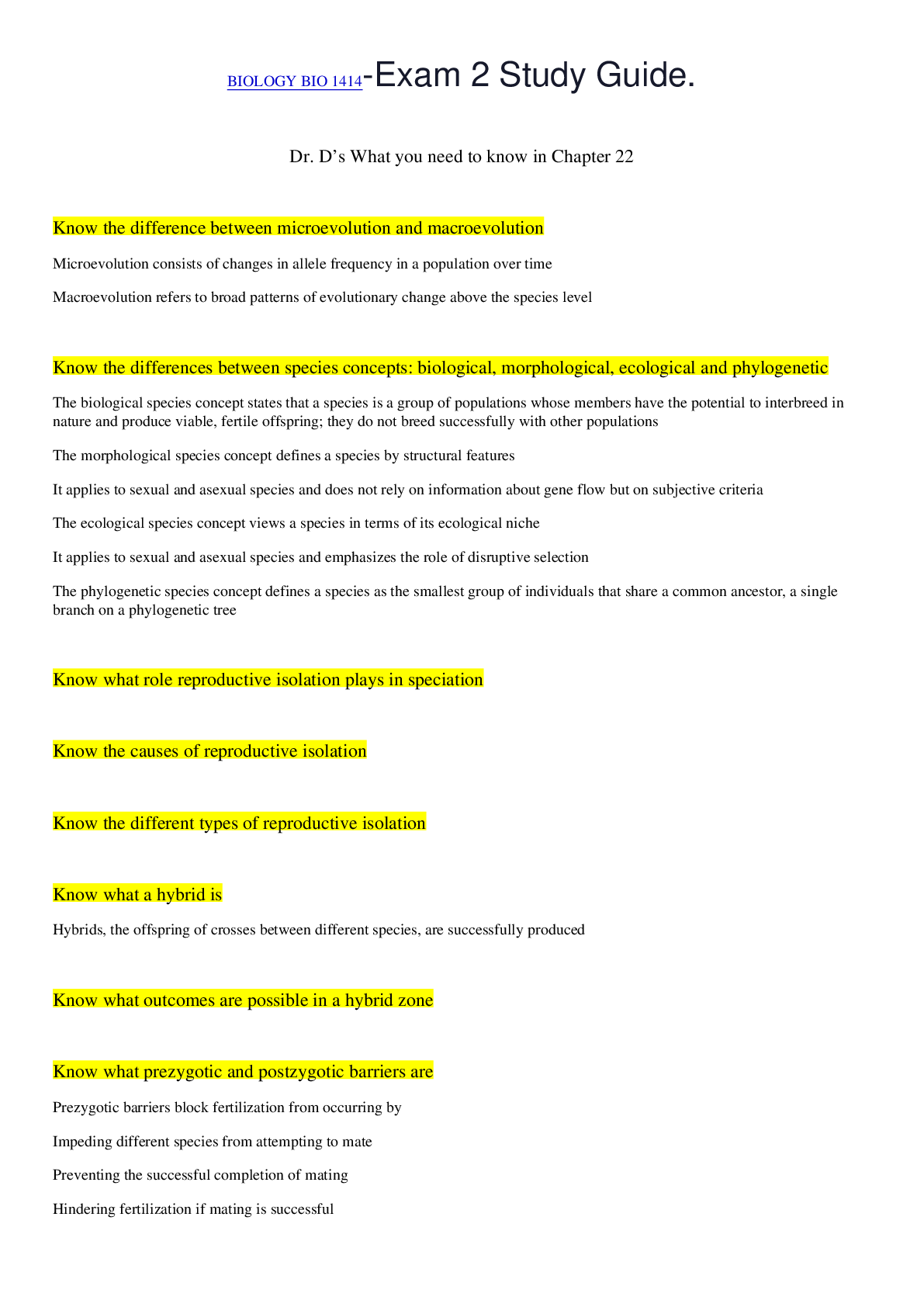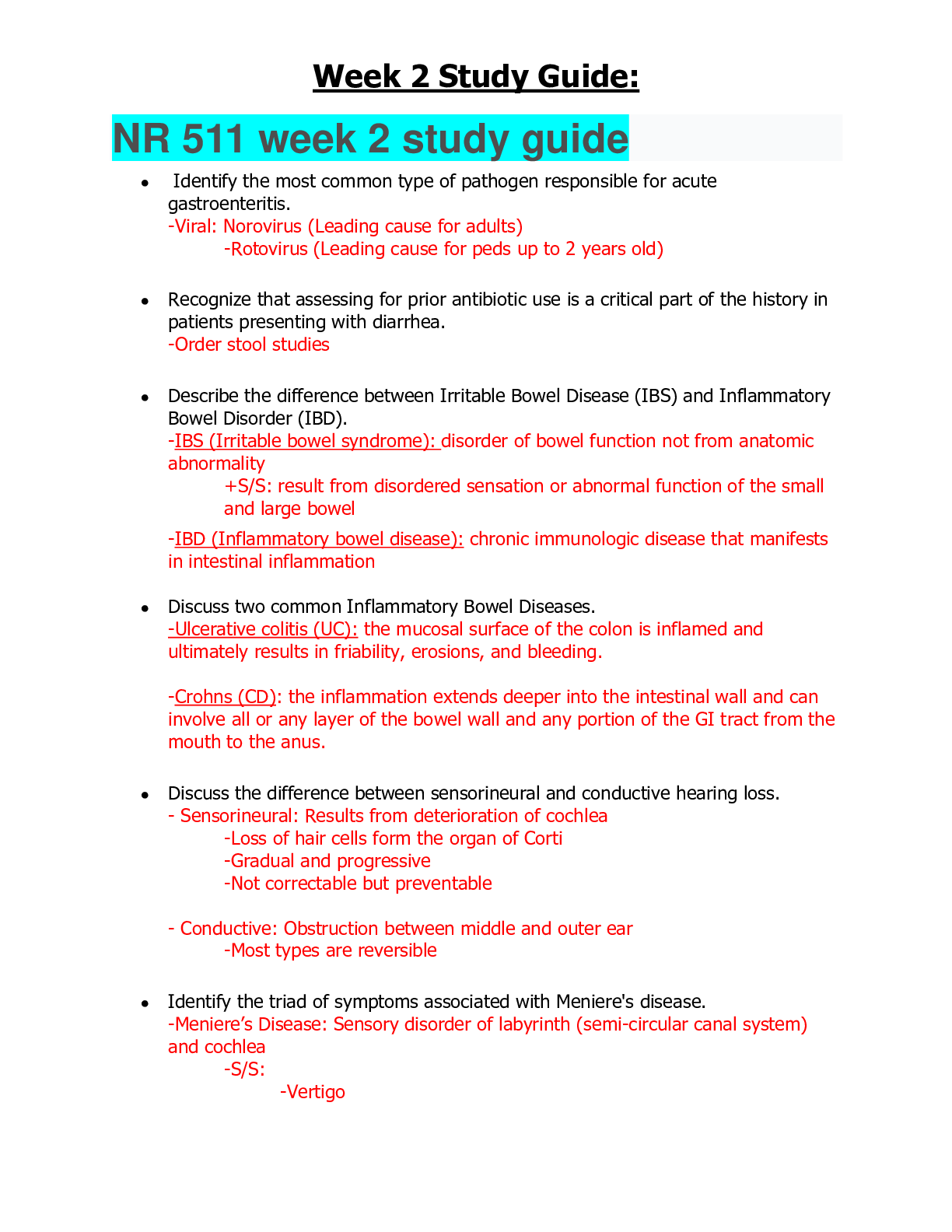*NURSING > STUDY GUIDE > NURS 3320 /NURS 3320 Test 2 Study Guide Assessment 2. COMPLETE GUIDE (All)
NURS 3320 /NURS 3320 Test 2 Study Guide Assessment 2. COMPLETE GUIDE
Document Content and Description Below
NURS 3320 /NURS 3320 Test 2 Study Guide Assessment 2. COMPLETE GUIDE.1. Know the types of skin cancer and the risk factors for skin cancer. • Skin cancer is the most common of cancers. • It occ... urs in three types: melanoma, basal cell carcinoma (BCC), and squamous cell carcinoma (SCC). • BCC and SCC are nonmelanomas. • Precursor lesions occur for some melanomas (benign or dysplastic nevi) and for invasive SCC (actinic keratoses or SCC in situ), but there are no precursor lesions for BCC. • BCC is the most common skin cancer in Caucasians • SCC is the most common in darker skin. • Asians are less susceptible to skin cancers. • African Americans, Asians, and Hispanics, although less susceptible than Caucasians, are susceptible to melanoma. • Asian Americans and African Americans tend to present with more advanced disease at diagnosis than do Caucasians. • African Americans, Asians, Filipinos, Indonesians, and native Hawaiians develop melanomas on non-exposed skin with less pigmentation, such as on palms, soles, mucous membranes, and nail regions. • Non-melanocyte skin cancers are the most common worldwide and are also increasing in populations heavily exposed to sunlight, especially in areas of ozone depletion. • Malignant melanoma is the most serious skin cancer. • It is the most rapidly increasing form of cancer in the United States; between 68,130 cases and 114,900 cases are expected to be diagnosed in the US in 2012. HEALTHY PEOPLE 2020 GOALS • Reduce melanoma cancer death rate. • Increase participation in reducing exposure to harmful ultraviolet (UV) irradiation, sunburn, and use of artificial sources of UV light for tanning. • Increase participation in protective measures that may reduce the risk of skin cancer. SCREENING all people over 20 years of age should have a periodic examination of their skin by a primary care provider, and all should do routine self-examinations (see Box 14-1). These recommendations are not supported by the U.S. Preventive Health Task Force report (2009), which provides broad reviews of studies showing insufficient evidence to support the benefits or harm of using a whole-body skin examination either by a primary care provider or self-examination for the early detection of cutaneous melanoma, BCC, or SCC in the adult general population. RISK ASSESSMENT Assess for the Following Risk Factors • Sun exposure, especially intermittent pattern with sunburn; risk increases if excessive sun exposure and sunburns began in childhood. • Intermittent exposure to the sun or UV radiation is associated with greatest risk for melanoma and for BCC • overall amount of exposure is thought to be associated with SCC. • SCC is most common on body sites with very heavy sun exposure • BCC is most common on sites with moderate exposure (e.g., upper trunk or women’s lower legs). • Non-solar sources of UV radiation (tanning booth, sunlamps, high-UV geographical areas). Indoor tanning is listed by as one of the most dangerous cancer-causing substances (along with plutonium, cigarettes, and solar radiation) Medical therapies such as PUVA and ionizing radiation • Family or personal history and genetic susceptibility (especially for malignant melanoma) • Moles, especially atypical lesions • Pigmentation irregularities (albinism, burn scars) • Fair skin that burns and freckles easily; light hair; light eyes • Age; risk increases with increasing age • Actinic keratoses Actinic keratoses, round or irregularly shaped tan, scaly lesions that may bleed or be inflamed (premalignancy). • Waxy or raised lesion, especially on sun-exposed (basal cell carcinoma) • Irregularly shaped lesion or scaly, elevated lesion (squamous cell carcinoma, melanoma) • Male gender (for nonmelanoma cancers), especially white men over 50 • Chemical exposure (arsenic, tar, coal, paraffin, some oils for nonmelanoma cancers) • Human papillomavirus (nonmelanoma cancers) • Xeroderma pigmentosum (rare, inherited condition) • Long-term skin inflammation or injury (nonmelanoma) • Alcohol intake (BCC) • smoking (SCC) • Inadequate niacin (vitamin B3) in diet • Bowen’s disease (scaly or thickened patch) (SCC) • Depressed immune system 2. What are the common symptoms of diabetes? • Acanthosis nigricans (AN), a linear streak-like pattern in dark-skinned people, suggests diabetes mellitus • the lack of pain sensation may signal neuropathy in such disorders as diabetes • Suspect medial calcification sclerosis any time you calculate an ABPI of 1.3 or greater or measure ankle pressure at more than 300 mm Hg. This condition is associated with diabetes mellitus • Adults with large visceral fat stores located mainly around the waist (android obesity) are more likely to develop health-related problems than if the fat is located in the hips or thighs (gynoid obesity). • 5 pregnancies with gestational diabetes with last child. • Calf pain is the most common symptom • numbness, weakness, coldness, sores on toes • change in skin color of leg, • hair loss or slow growth on legs • shiny skin • slow-growing toenails • diminished pulses in legs and feet • erectile dysfunction in men • Fruity or acetone breath is associated with diabetic ketoacidosis. An ammonia odor is often associated with kidney disease. Foul odors may indicate an oral or respiratory infection, or tooth decay. Alcohol or tobacco use may be identified by breath odor. Fecal breath odor occurs in bowel obstruction; sulfur odor (fetor hepaticus) occurs in end-stage liver disease. • sleep timing and duration have effects on endocrine, metabolic, and neurologic functions, and chronic short sleep has been associated with heart disease, hypertension, obesity, diabetes, and all-cause mortality. • PAD--The disease prevalence increases with age and is associated with diabetes. The recommended age for ABI screening is 65 years of age (previously 70 years of age). It is also recommended that people with a history of diabetes or smoking should be screened starting at 50 years of age. Furthermore, people under 50 years of age with diabetes and other PAD risk factors, such as obesity or high blood pressure, should undergo ABI screening • Measuring hip: Females: Greater than 35 inches (88 cm) Males: Greater than 40 inches (102 cm) These findings are associated with such disorders as diabetes Fasting blood sugar (FBS) or blood glucose level Adult: 65–99 mg/dL Prediabetes 100–135 mg/dL Critical FBS Levels:<40 mg/dL or >400 mg/dL Increased in diabetes mellitus Hemoglobin A1c (glycosylated hemoglobin) Nondiabetic: 4%–6% Optimal diabetic control = <7% Correlation between % A1c & mean glucose level 6% = 126 7% = 154 8% = 183 9% = 212 10% = 240 11% = 269 12% = 298 (American Diabetes Association, 2010) Increased in diabetes mellitus [Show More]
Last updated: 2 years ago
Preview 1 out of 56 pages

Buy this document to get the full access instantly
Instant Download Access after purchase
Buy NowInstant download
We Accept:

Reviews( 0 )
$20.00
Can't find what you want? Try our AI powered Search
Document information
Connected school, study & course
About the document
Uploaded On
Feb 12, 2021
Number of pages
56
Written in
Additional information
This document has been written for:
Uploaded
Feb 12, 2021
Downloads
0
Views
61













